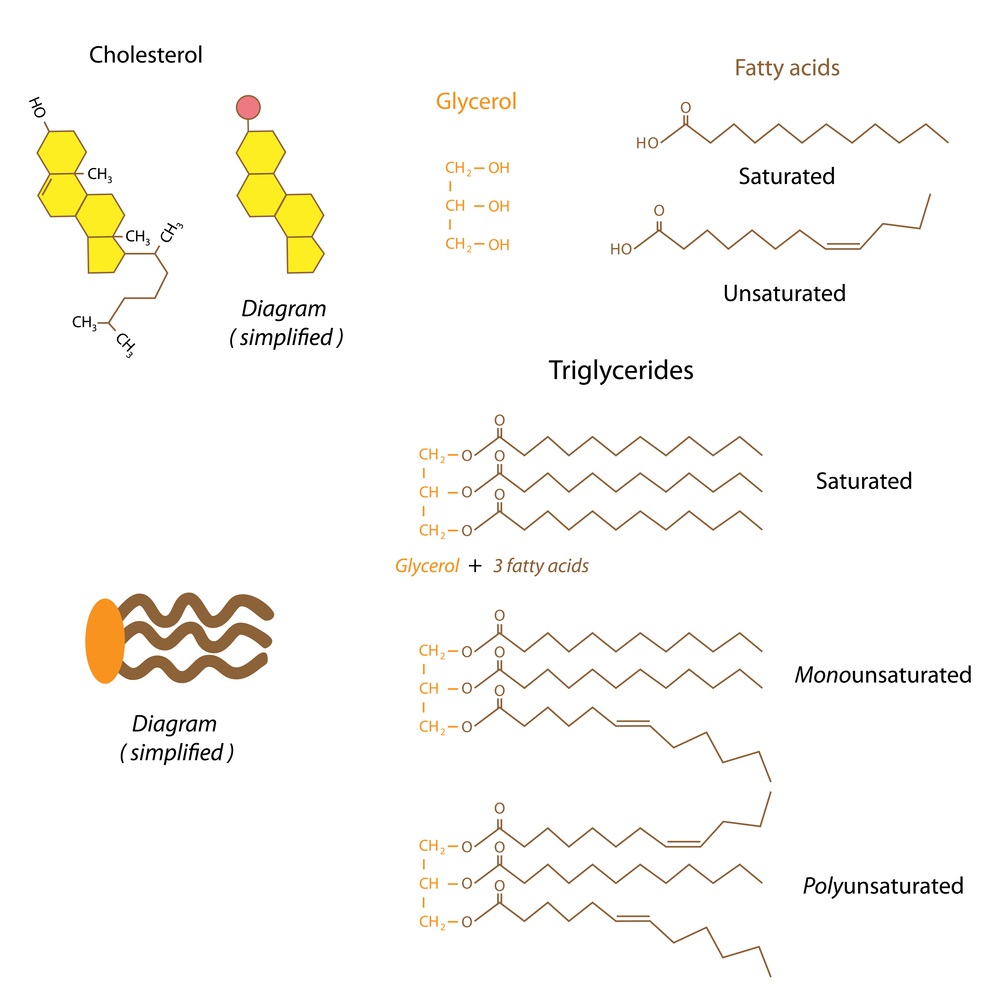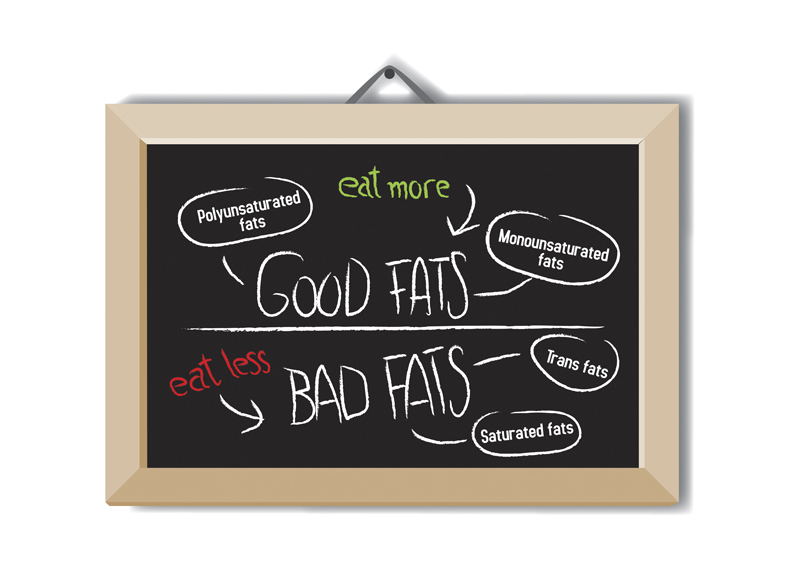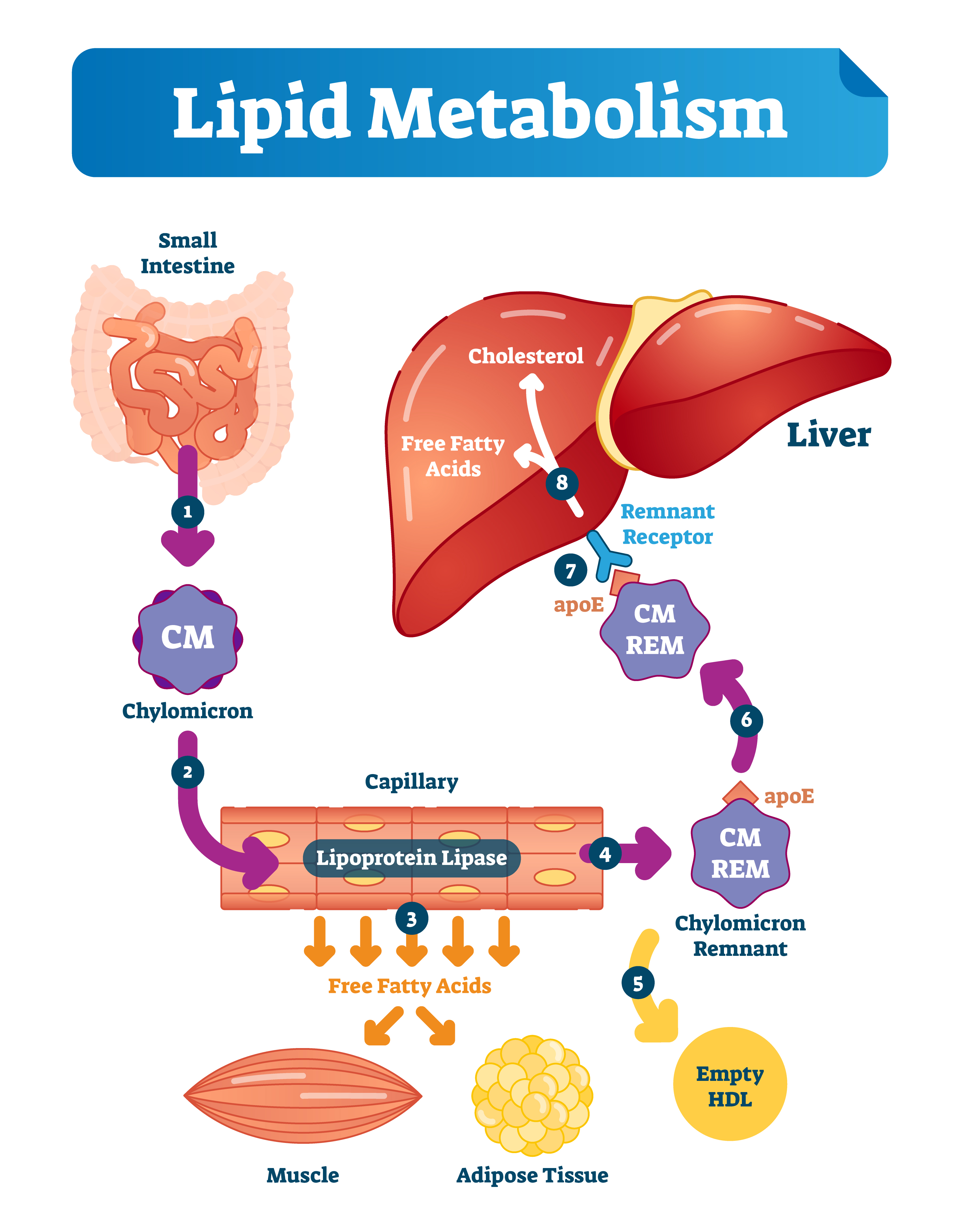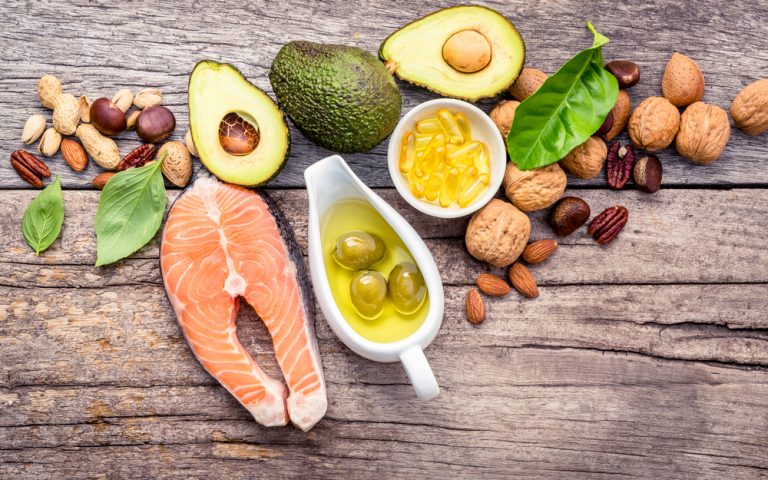What is the role of fat and what are its properties?
That's a good question
As you know, what we eat has a great impact on our intellectual and physical development. In order to make the most of our development potential, the diet must be rich in various foods that will contain adequate amounts of proteins, carbohydrates, vitamins, minerals and fats. And on fats, we will focus on this topic.
A lot of people skip fats in the diet thinking that they are the main cause of their obesity or other problems related to overweight. They think that the role of fats is very small and they are not needed. And here a serious mistake is made, as lipids are known to be lipids or complex molecules, otherwise called fatty acids, they fulfill very important roles in our body and without them we would not be able to function properly, among othersthe exclusion of fats or their inadequate supply causes serious cardiovascular diseases that currently threaten a very large number ofpeople, especially in highly developed countries where the lines are not taken care of without the basic principles of nutrition.
As you know, fats are much more energetic than carbohydrates, but the body is not happy to use them and traps them as a store that can be burned at a later date. It follows that the presence of fats in food is essential, especially when performing hard physical work. A lot of energy is needed then, and the proteins and carbohydrates themselves can not fully satisfy these needs. Then it is reasonable to introduce into the diet products rich in fats, both vegetable and animal. However, if the work does not require a large energy expenditure, it may happen that meals containing large amounts of fat will provide it in excess. Then the energy balance is disturbed and excess of energy not used for work will be transformed in metabolic processes into fat and stored in adipose tissue. Of course, you can not overdo it with fats.

It's no secret that a large amount of fats in foods increases their energy value.
Feeding on high energy products, with low physical activity, is a sure and simple way to obesity and other diseases associated with it. Food fats also have an adverse effect on blood composition, especially on the content of triglycerides, total cholesterol, and LDL cholesterol. Elevated concentration of these atherogenic blood serum indicators indicates abnormal lipid metabolism in the body and predisposes the development of atherosclerotic lesions in the blood vessels.
Such a dependency obviously does not apply to all people in turn. It has been found in elderly people, in people with a genetic innate predisposition to atherosclerosis, and when lipid metabolism is already disturbed by the coexistence of other diseases, such as diabetes, obesity or some hormonal disorders.
A large amount of fat in food, which according to our dietary habits is mostly of animal origin, of course creates further risks.In such a diet, as a rule, too much cholesterol is present and there is an incorrect composition of fatty acids.Cholesterol contained in foods causes an increase in cholesterol and other atherosclerotic indicators in the blood.Then the atherosclerotic lesions in the blood vessels are faster.
A similar effect is shown by saturated fatty acids contained in food, in which the main source of fat are greasy meat, lard, fat, fat milk and butter.In these products, however, there are few monounsaturated and polyunsaturated fatty acids that provide the human body with the essential unsaturated fatty acids EFA.
In order to maintain good health, at least 1 to 2% of the daily energy should come from the combustion of EFAs.The saturated fatty acids of food are most dangerous for health.It is believed that they are even more dangerous than the cholesterol itself contained in excess in some foods.Thus, a food rich in fats, and especially in animal fats, is a simple way to obesity, hypertension, atherosclerosis and other heart diseases, as well as some cancers in women - nipples and ovaries, and in men - colon and prostate.Of course, it does not have to be this way, because fats are not only pork chops on universal oil, it is primarily healthy fats, without which our body can not function.
Let's start with divisions!
Fats can be divided into different categories, for example the origin of fats can be divided into vegetable - where the most is found in seeds, fruit flesh and animal found in all living organisms, for example in subcutaneous adipose tissue or in cells. and the organs of various organisms. We could write a lot more about the construction of fats, but I would run away a bit from the subject, so I will try to explain it reasonably and legibly. As I wrote above, fats or lipids are found in all organisms, they form part of tissues, they provide storage of substances regulating the solubility of important vitamins K, E, A, D. Next division is the division of lipids (fats) in terms of their chemical structure we distinguish fats simple and complex. The first one is a combination of hydrogen and hydrogen carbon, for example glycerol esters and fatty acids. In contrast, complex fats are those that are made of carbon, hydrogen, oxygen contain other compounds, such as nitrogen bases, sulfuric acids, etc.
We distinguish several types of fatty acids n- saturated fatty acids (no double bonds, which are characterized by single bonds between the carbon), n- unsaturated fatty acids (there are a pair of double double bonds), n- monounsaturated fatty acids (one double bond between carbon atoms) and n- polyunsaturated fatty acids (two or more double bonds).
A lot of monounsaturated fatty acids, as I have already mentioned, contains olive oil, it works very well, on the cardiovascular system and contrary to the belief that you can not fry on vegetable oils so the oils containing these acids (monounsaturated) are suitable for frying why? Because they have only one double bond, they are not susceptible to oxidation and high temperature. As much as sunflower or corn oil. Sam approaches this statement with a slight grain in the eye because there is no perfect oil, everyone has some disadvantages.

In my opinion, you can successfully fry shortly for example eg scrambled eggs or something to heat just on olive oil because as I wrote above it is relatively heat-resistant, - unsaturated fatty acids - their characteristic feature is that they attach hydrogen as well as oxygen very easily it is a feature of all double compounds. This is used, for example, in curing (hydrogenation) processes in the production of, for example, margarines. Most unsaturated acids are found in vegetable fats, although they are also found in animal fats. If you have ever wondered why, for example, oils are liquid, I will tell you that they owe this mostly high levels of unsaturated fatty acids. The exception are vegetable oils such as palm and coconut oil, and this is because they contain large amounts of saturated fatty acids and in a normal (room) temperature they have a constant consistency. And from animal fats, fish that are liquid like vegetable oils.In these fats there is a lot of unsaturated fatty acids, which is known to be very important for humans, but it will be a bit wider below, - polyunsaturated fatty acids (PUFA) - the main representative of the family -6 PUFA is linoleic acid, found in the seeds of oil plant.
The oils rich in this acid are corn, soybean, sunflower oil as well as soft margarine. However, the representative of WNKT-3 is linolenic acid (ALA), which occurs in some vegetable oils (linseed, rapeseed) and most of it is in plankton and fish that feed on this plankton. As is known, the family of Omega-3 and Omega-6 acids belong to the group of polyunsaturated acids, ie those that have at least two double bonds between carbon atoms.The difference between them, expressed by the so-called. The omega number refers to the place where the first double bond occurs in the carbon chain. And so in the case of O-3, the first double bond occurs after the third carbon atom, and in the case of O-6 only on the sixth carbon atom, so it is already known from where the numbers 3 and 6.
Let's take a closer look at Omega-3 acids. One of the most well-known representatives of O-3 is ALA, or alpha-linolenic acid contained in linseed, linseed oil, walnuts, soybean rapeseed oil. Equally important acids are DHA, i.e. deoxyhexaenoic acid and EPA or eicosapentanoic acid. They occur in fatty ocean fish or seaweed.They are very important for the human body, DHA is particularly important for the proper functioning of the brain, for example, the cerebral cortex is made up of about 60% of this fatty acid.An equally important role of DHA is the use of this fatty acid for the construction of neurotransmitters.So in summary it affects mental abilities in the broad sense of the word.
The research carried out shows that people who suffer from depression have very low levels of DHA in blood, another interesting feature is that DHA is the building block for the production of serotonin and dopamine. All the information I mentioned about DHA is very important, but we practicing we always want to make something positively affect our figure and according to studies conducted on rats, the consumption of larger amounts of O-3 influenced the better development of neuronal synapses, which resulted in this that they did much easier with training than rats where O-3 acids were scarce.

So adding DHA to our everyday menu we have a great influence on our well-being and health. An equally important acid in addition to DHA is EPA, which determines the proper synthesis of eicosanoids - they are biologically active molecules, called tissue hormones, they are released from cell membranes, which in turn are made of phospholipids. Eicosanoids are responsible for antithrombotic and anti-inflammatory effects, inhibit the development of cancerous tumors and reduce the contractility of blood vessels.
The best products from the Omega-3 category.
Let's focus now on Omega-6 acids. Omega-6 acids are the most common acids in the diets of all people (I mean proverbial) they occur in fast-fodach, margarines, etc. - They have nevertheless been included in EFAs or essential unsaturated fatty acids due to the fact that the body without them can not function. EFA deficiencies cause mass changes in the human body, among othersenlargement of the heart, renal hypertension, enlargement of all organs, of course side effects resulting from a deficiency of EFAs is a whole lot, but in today's world it is difficult to provide these acids, because the daily menu is rich in these fatty acids.However, their common excess in our diet causes a problem.
A rich source of Omega-6 acids are sunflower and soy vegetable oils. Their excessive consumption contributes to the increase of inflammation in the body.According to various studies, higher consumption of O-6 is indicative of pro-cancer activity while Omega-3 acts analogously to Omega-6. Of course, O-6 has many advantages, hence the name of the essential fatty acids.They are necessary for the proper development of the young body and for the maintenance of good health throughout life. They are essential components of tissues, moreover, they are needed for the proper transport of lipids in the body.
EFAs are precursors of prostaglandins and their derivatives, thanks to which they have the ability to prevent blood clots, lower serum lipid markers and prevent atherosclerosis. Not the right proportion of Omega-6 consumption in relation to Omega-3 is the basic factor lowering the o-3 level in the body. Why? Because both O-3 and O-6 support the same enzyme, allowing the conversion of acids into the body's proper form. In summary, the diet of every human should be rich in Omega-3 and proportionally matched amounts of Omega-6.
It should also be remembered that a lot of alcohol abuse lowers our O-3 reserves, so you have to use alcohol with the wisdom.Lowering the levels of O-3 is also caused by the lack of vitamins and minerals that improve metabolism of vitamins such as B group are responsible for the biochemical transformations of fats;or vitamin E, which protects all unsaturated acids from oxidation after ingestion. You also have 3 important factors that cause a decrease in the O-3 value in the body ... This is our age, our age is aging, which causes the reduction of activities necessary for normal enzymatic metabolism of fats, including D4 (desaturase) which is necessary for the correct synthesis of DHA from EPA.
Generally, the deficiencies in the diet cause many diseases, the modern science of nutrition assumes that both malnutrition and excess nutrition cause shorter life span, increased sensitivity to diseases, impairment of psycho-physical performance. Considering the main causes of diseases and mortality in various countries around the world, it can be concluded that abnormal nutrition consisting in nutritional deficiencies, especially energy, protein and such basic ingredients as vitamins and minerals, as well as excessive nutrition consisting mainly in providing excessive energy with food contributes to to more deaths than any other environmental factor.
Remember that choosing everything with common sense creates better conditions for our body, the same applies to reducing body fat or building, for example, mass.






